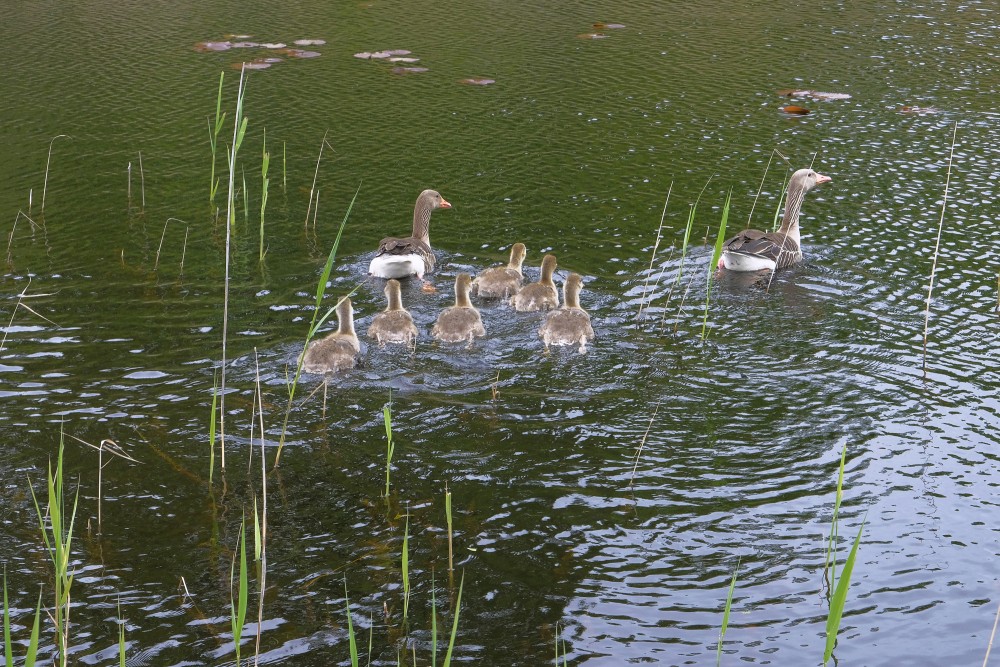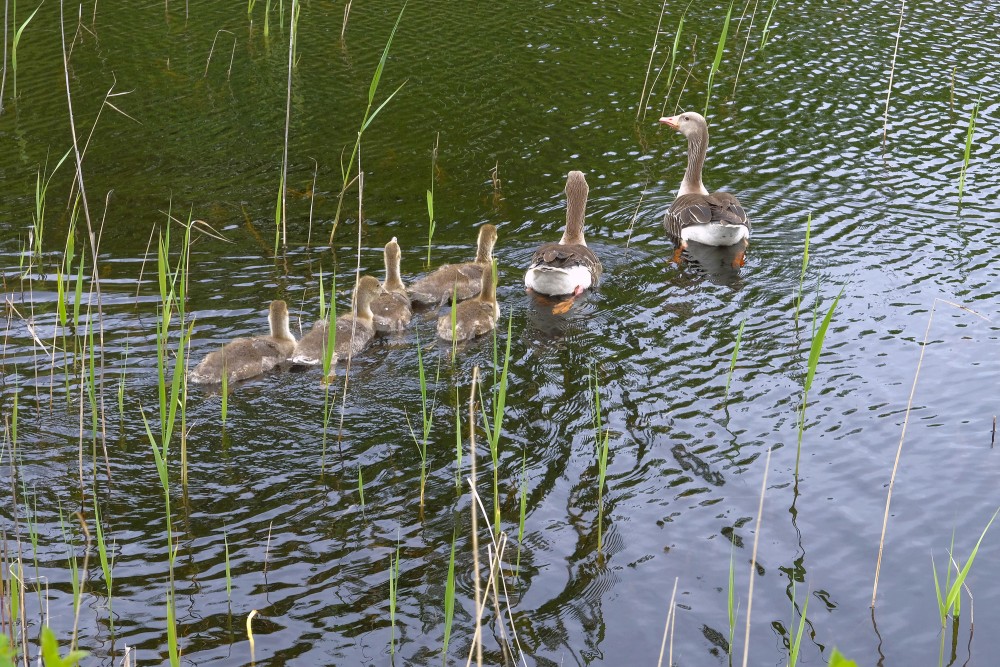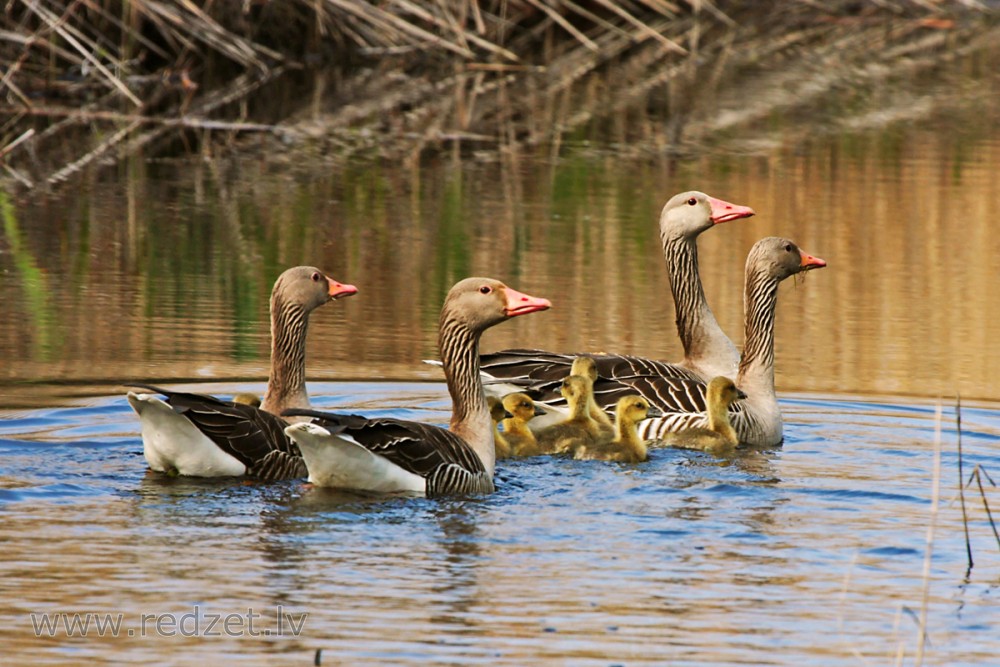Greylag goose (Anser anser)
The greylag goose (Anser anser) is a species of large goose in the waterfowl family Anatidae and the type species of the genus Anser. It has mottled and barred grey and white plumage and an orange beak and pink legs. A large bird, it measures between 74 and 91 centimetres (29 and 36 in) in length, with an average weight of 3.3 kilograms (7.3 lb). Its distribution is widespread, with birds from the north of its range in Europe and Asia migrating southwards to spend the winter in warmer places. It is the type species of the genus Anser and is the ancestor of the domestic goose, having been domesticated at least as early as 1360 BC. The genus name is from anser, the Latin for "goose".
Review made by Consordini team
Greylag geese travel to their northerly breeding grounds in spring, nesting on moorlands, in marshes, around lakes and on coastal islands. They normally mate for life and nest on the ground among vegetation. A clutch of three to five eggs is laid; the female incubates the eggs and both parents defend and rear the young. The birds stay together as a family group, migrating southwards in autumn as part of a flock, and separating the following year. During the winter they occupy semi-aquatic habitats, estuaries, marshes and flooded fields, feeding on grass and often consuming agricultural crops. Some populations, such as those in Southern England and in urban areas across the species' range, are primarily resident and occupy the same area year-round.
| Greylag goose | |
| Kingdom: | Animalia |
| Phylum: | Chordata |
| Class: | Aves |
| Order: | Anseriformes |
| Family: | Anatidae |
| Genus: | Anser |
| Species: | A. anser |
Taxonomy
Anser anser, the greylag goose, is a member of the waterfowl family Anatidae. It was first described by the Swedish naturalist Carl Linnaeus in 1758 as Anas anser, but was transferred two years later to the new genus Anser, erected by the French zoologist Mathurin Jacques Brisson, where it is the type species. Two subspecies are recognised; A. a. anser, the western greylag goose, breeds in Iceland and north and central Europe; A. a. rubrirostris, the eastern greylag goose, breeds in Romania, Turkey and Russia eastwards to northeastern China. The two subspecies intergrade where their ranges meet. The greylag goose sometimes hybridises with other species of goose including the barnacle goose (Branta leucopsis) and the Canada goose (Branta canadensis), and occasionally with the mute swan (Cygnus olor). The greylag goose was one of the first animals to be domesticated; this happened at least 3000 years ago in Ancient Egypt, the domestic breed being known as A. a. domesticus. As the domestic goose is a subspecies of the greylag goose they are able to interbreed, with the offspring sharing characteristics of both the wild and tame birds.
Description
The greylag is the largest and bulkiest of the grey geese of the genus Anser, but is more lightly built and agile than its domestic relative. It has a rotund, bulky body, a thick and long neck, and a large head and bill. It has pink legs and feet, and an orange or pink bill with a white or brown nail (hard horny material at tip of upper mandible).[6] It is 74 to 91 centimetres (29 to 36 in) long with a wing length of 41.2 to 48 centimetres (16.2 to 18.9 in). It has a tail 6.2 to 6.9 centimetres (2.4 to 2.7 in), a bill of 6.4 to 6.9 centimetres (2.5 to 2.7 in) long, and a tarsus of 7.1 to 9.3 centimetres (2.8 to 3.7 in). It weighs 2.16 to 4.56 kilograms (4.8 to 10.1 lb), with a mean weight of around 3.3 kilograms (7.3 lb). The wingspan is 147 to 180 centimetres (58 to 71 in). Males are generally larger than females, with the sexual dimorphism more pronounced in the eastern subspecies rubirostris, which is larger than the nominate subspecies on average.
The plumage of the greylag goose is greyish brown, with a darker head and paler breast and belly with a variable amount of black spotting. It has a pale grey forewing and rump which are noticeable when the bird is in flight or stretches its wings on the ground. It has a white line bordering its upper flanks, and its wing coverts are light coloured, contrasting with its darker flight feathers. Its plumage is patterned by the pale fringes of the feathers. Juveniles differ mostly in their lack of black speckling on the breast and belly and by their greyish legs. Adults have a distinctive 'concertina' pattern of folds in the feathers on their necks.
The greylag goose has a loud cackling call similar to that of the domestic goose, "aahng-ung-ung", uttered on the ground or in flight. There are various subtle variations used under different circumstances, and individual geese seem to be able to identify other known geese by their voices. The sound made by a flock of geese resembles the baying of hounds. Goslings chirp or whistle lightly, and adults hiss if threatened or angered.
Distribution and habitat
This species has a Palearctic distribution. The nominate subspecies breeds in Iceland, Norway, Sweden, Finland, the Baltic States, northern Russia, Poland, eastern Hungary and Romania. It also breeds locally in the United Kingdom, Denmark, Germany, Austria, the Czech Republic, Slovakia and North Macedonia. The eastern race extends eastwards across a broad swathe of Asia to China. European birds migrate southwards to the Mediterranean region and North Africa. Asian birds migrate to Azerbaijan, Iran, Pakistan, northern India, Bangladesh and eastward to China. In North America, there are both feral domestic geese, which are similar to greylags, and occasional vagrant greylags. Greylag geese seen in the wild in New Zealand probably originated from the escape of farmyard geese, and a similar situation has occurred in Australia, where feral birds are now established in the east and southeast of the country.
In their breeding quarters, they are found on moors with scattered lochs, in marshes, fens and peat-bogs, besides lakes and on little islands some way out to sea. They like dense ground cover of reeds, rushes, heather, bushes and willow thickets. In their winter quarters, they frequent salt marshes, estuaries, freshwater marshes, steppes, flooded fields, bogs and pasture near lakes, rivers and streams. They also visit agricultural land where they feed on winter cereals, rice, beans or other crops, moving at night to shoals and sand-banks on the coast, mud-banks in estuaries or secluded lakes. Large numbers of immature birds congregate each year to moult on the Rone Islands near Gotland in the Baltic Sea.
Since the 1950s, increases in winter temperatures have resulted in greylag geese, breeding in central Europe, reducing their winter migration distances. Wintering grounds closer to home can therefore be exploited, meaning that the geese can return to set up breeding territories earlier the following spring.
In Great Britain, their numbers had declined as a breeding bird, retreating north to breed wild only in the Outer Hebrides and the northern mainland of Scotland. However, during the 20th century, feral populations have been established elsewhere, and they have now re-colonised much of England. These populations are increasingly coming into contact and merging.
The greylag goose has become an invasive species in several areas. In Norway, the number of greylag geese is estimated to have increased three- to fivefold between 1995 and 2015. As a consequence, farmers' problems caused by goose grazing on farmland has increased considerably. This problem is also evident for the pink-footed goose. In the Orkney islands the population has increased dramatically: there were 300 breeding pairs, increasing to 10,000 in 2009, and 64,000 in 2019. Due to extensive damage caused to crops, the hunting season for the greylag goose in the Orkney islands is now most of the year.
en.wikipedia.org











